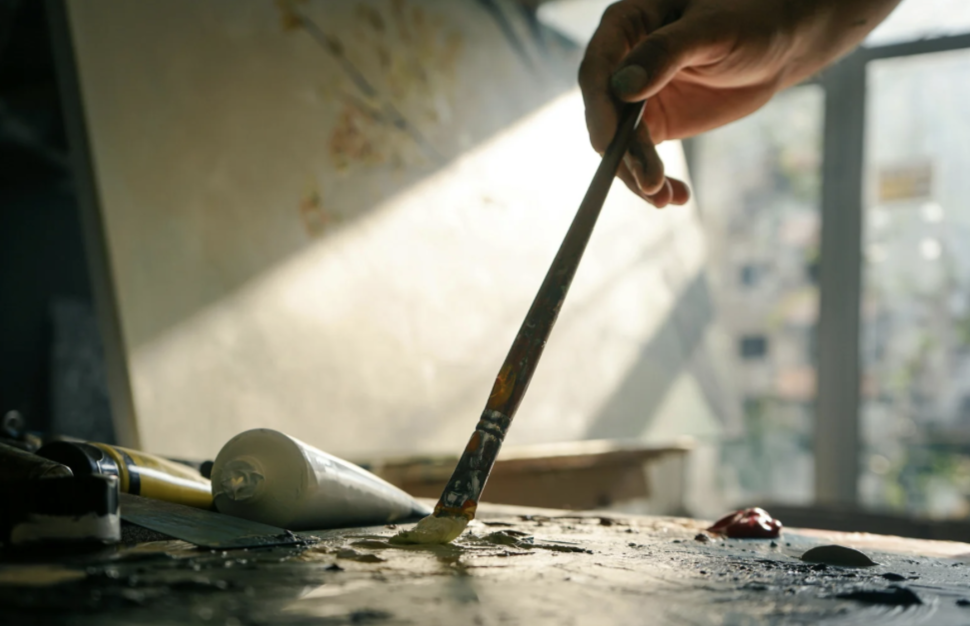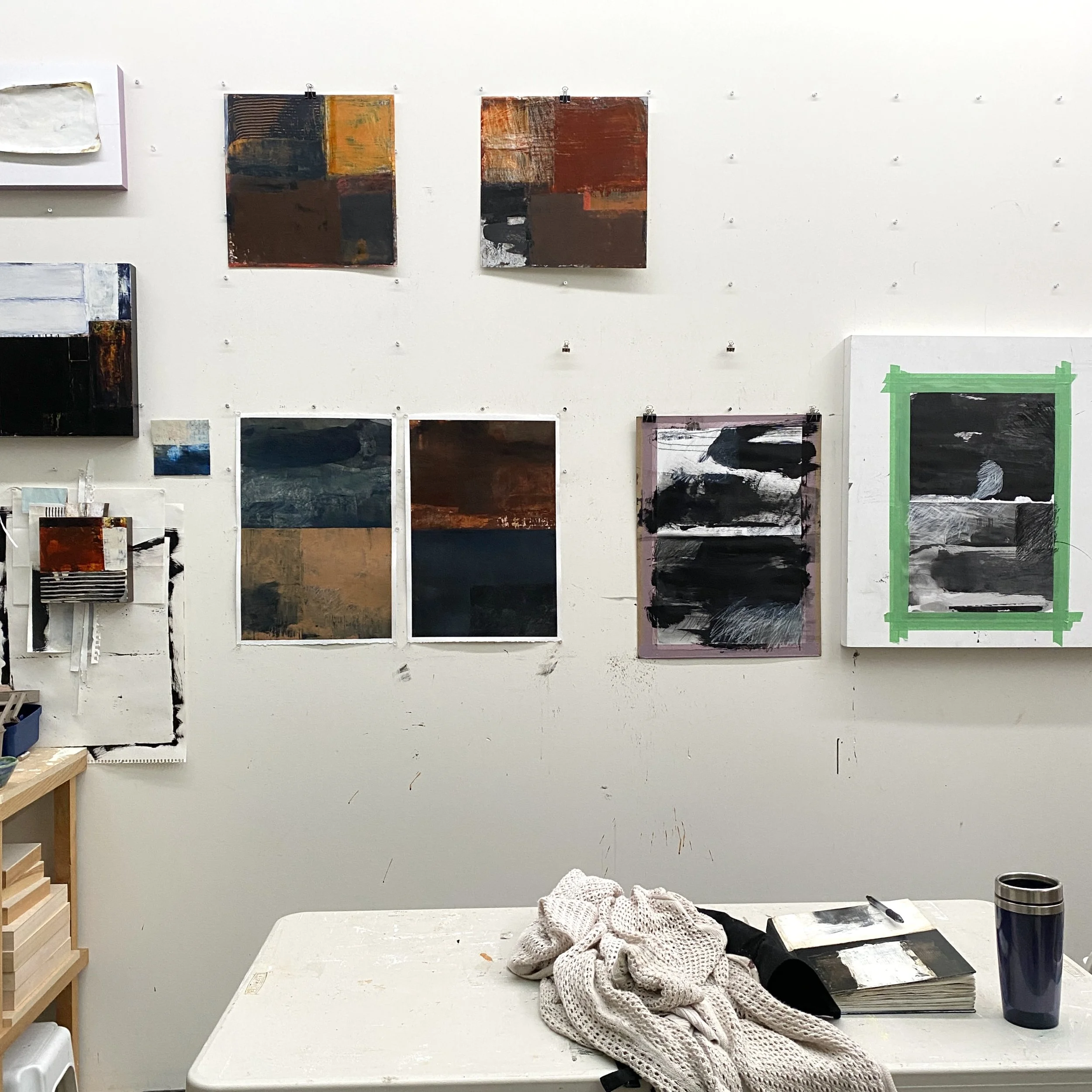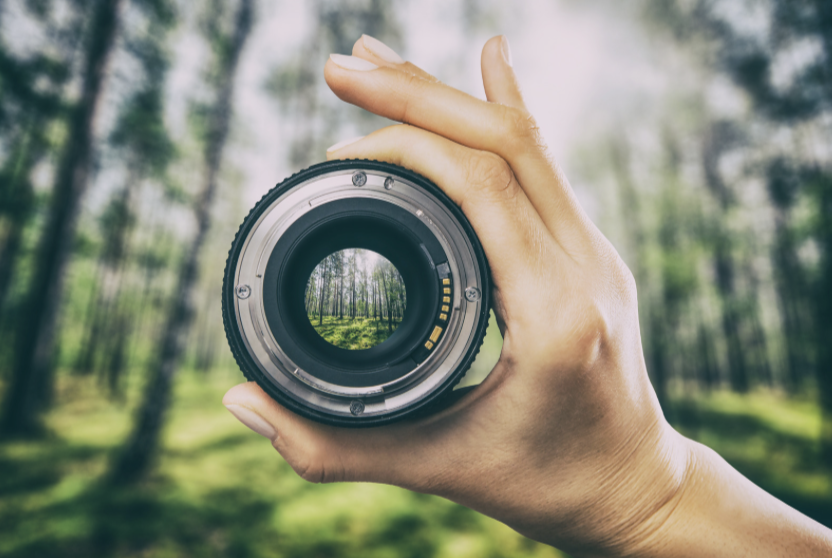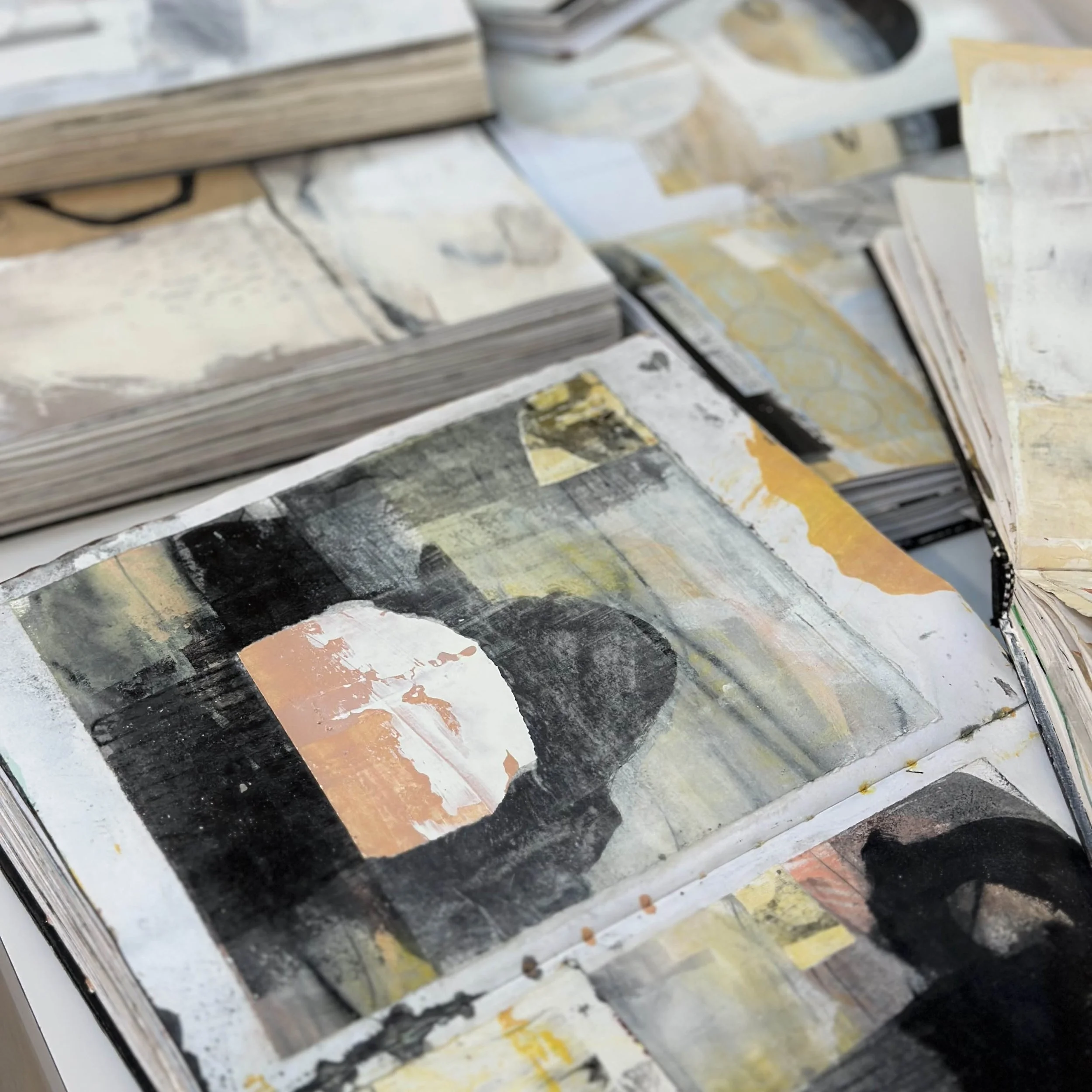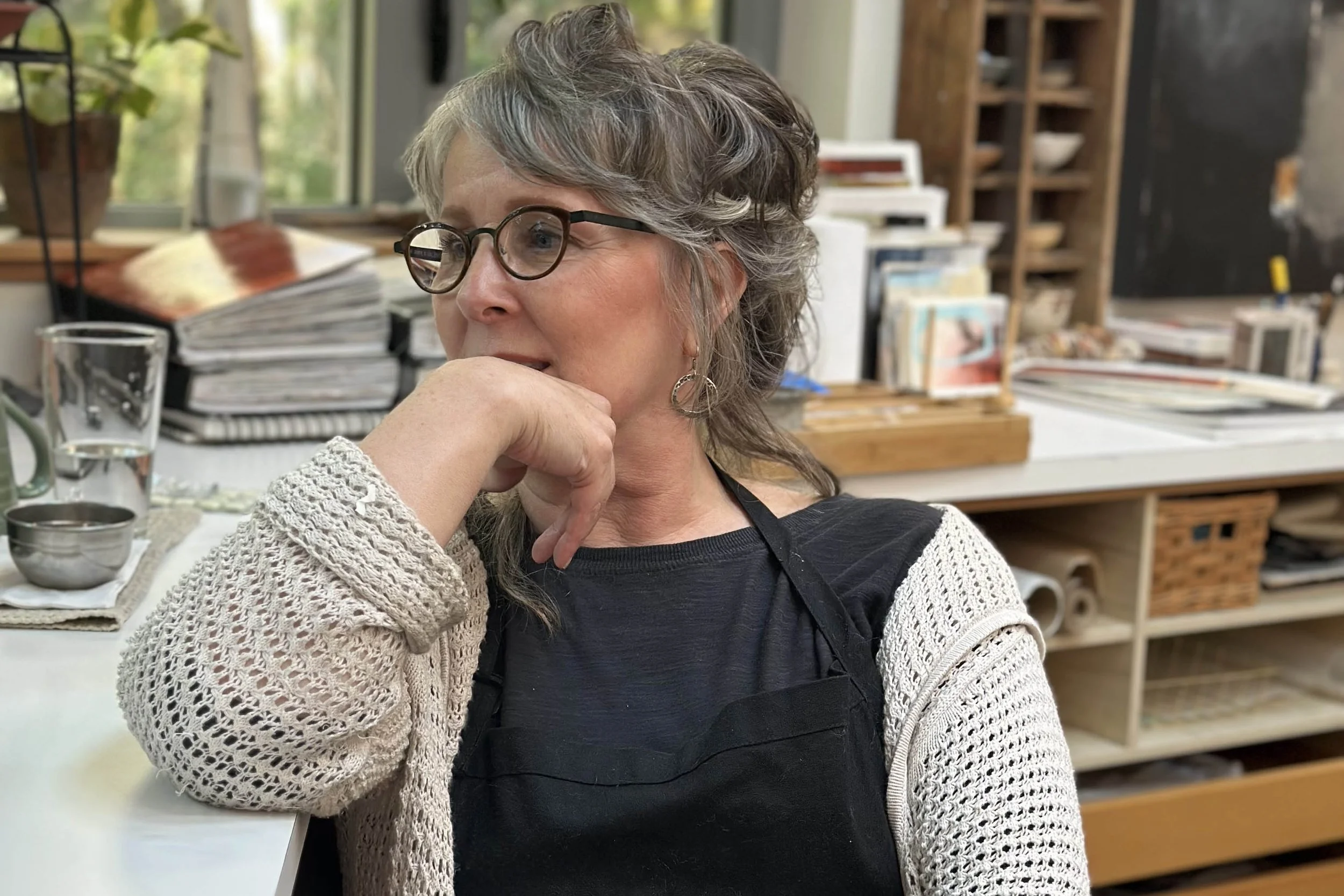Artists are often navigating the paradoxical aspects of art-making. It’s one of the many inherent characteristics of the creative process that keeps us engaged and challenged, sometimes in equal measure.
For instance, we know the benefits of making a cohesive and consistent body of work, as well as working with a set of intentions to help guide us in that process. And we can simultaneously feel the impetus to move somewhere else with our work. We may be compelled to expand into new territory, take bigger risks, and follow a path that may be leading us away from where we have been. These are the drivers that propel our work forward, and we need to pay attention to them, even as they unsettle us.
At times when we feel ready to evolve in our work – taking that step into the unknown once more – the question we need to hold is, how can we allow ourselves to expand into new territory while staying connected to our voice as an artist?
There is also an important distinction to understand about this process of evolution in art-making. It is invaluable to build consistency in our artistic practice through coming to know who we are as an artist, and to make meaningful work. In order to do this we have to stay the course, even when it is uncomfortable, to develop our creative language, learn to work with intentions, and build a strong body of work that reflects our voice and offers us a solid working structure. We need to commit, focus, and recognize the inherent value of this approach to our creative work.
What I mean by this is, when you have been focused on your development for a period of time – perhaps you’ve even had some measure of success for yourself – you may still feel restless and compelled to move elsewhere in your work. This restlessness can occur despite the fact that others recognize your work, you’ve made sales, had opportunities to show, and have a following.
This can be a highly unsettling time for artists. If we’re not prepared to meet it well, as we need to do with all the paradoxical aspects of the creative process, we’ll find ourselves in a great deal of confusion and struggle.
At these times we need to be Jedi Masters of the mind, separating out what is a “driver” in our art practice and what is a “limiter.”
Drivers are the nudges that move us forward and ask us what else is possible. They are the feeling that change is needed in order to feel alive in the work once more. But, they are anchored in our vision and passion, not in our fear and avoidance – those are limiters.
Drivers expand and open us. Limiters contract and close us. Drivers are curious and adventurous. Limiters are fearful and withdraw us from forward movement or risk taking.
So a good litmus test when you notice an unsettledness arriving, or a feeling of wanting to move elsewhere in your work, is to lean into that feeling and ask yourself, “Is this a driving force or a limiting thought or feeling?”
Perhaps you’re at an impasse in your painting process, and unsure of where to go next. A driving thought in this instance might sound like, “It feels like something more is needed here, I wonder what that is?” or “ I like where this is going, but I feel it needs a breath of fresh air, something unexpected or stimulating. How could I approach this?” You can hear the invitation here, the curious language, along with the restlessness and awareness of something new wanting to arrive in the work.
In this same case, a limiting thought or feeling would sound more like, “This feels wrong. I can’t figure it out and I should just give up. It’s never going to be any good, even if I do find my way out of this mess.” Or it might even sound more compassionate towards your challenge, but still suggestive of your limits. “You’ve been working on this piece for over an hour now, it’s such a mess. Maybe you need to shift gears and go do something else.”
Here you can see that we are limiting ourselves by not staying engaged. Even if the work is a struggle and we need a break, taking a break that keeps us curious about what has arrived and what might be possible is moving us forward. Maybe we do some reflective writing about the work, make some sketches of the piece, make some collage paper to try on the work for compositional possibilities. And if we do fully take a break, we stay engaged with the work, perhaps by walking and thinking about it, letting it percolate in our mind. We don’t want to engage with stimulation and distract ourselves, because that is avoidance of the work itself. It will not help us to find the answers we want, just muddy the waters. So we need to be sensitive to this and attend to ourselves well.
Let's take a closer look at how drivers and limiters differ:
Drivers feel like a knowing or a sensing that there is more available to you – that you’re making the work, but the work wants more from YOU.
Drivers often arrive with a feeling of restlessness. We want to move, but we don’t know where yet. The idea of moving is fuel for us, but we may not yet be burning that fuel. We’re often moving very slowly and methodically, in our work.
Drivers are igniters and lead us towards risk taking. We feel a sense of expansion and excitement, often paired with a bit of confusion about what this means for our work.
Drivers speak to us in opportunity language, and open-ended questions like “what if?” or “how could I?” We feel a sense of excitement around the possibility of where we might go in the work, and that can be paired with a sense of uncertainty as well.
Limiters can feel like drivers, except they arrive as a result of attempting to manage your struggle in the work. They make you feel like a change would be a relief from that struggle. Let’s launch a diversion and get outta here!
Limiters are thoughts that arrive as you’re working that are not in support of your growth, but want you to play it safe. They don’t support you in staying in the deeper work and risking, but suggest that it will be easier over there, doing something different.
Limiters are feelings of restriction and unwillingness to let go. There is a sense of grasping and holding. There may be a “what if?” question roaming around inside you, but it’s often accompanied by a belief that something bad will be the outcome. “What if I move in this direction and get completely lost in my work and waste my time?”
Limiters are avoidance thoughts, fear based thoughts, and thoughts that defeat your efforts to make work – any work. They often feel like dissatisfaction with what you’re making, but without any real basis for that judgement. For instance, a work is still forming, in its early stages and the limiting thought arrives, “this isn’t any good.” Or, “what am I doing?” both delivered with a judgy tone.
That single phrase, “What am I doing?” can be a driver when spoken with curiosity and a willingness to unpack the process in reflection, or be a limiter when spoken with disdain and self-judgement.
I love this quote from Rick Rubin’s book, ‘The Creative Act’:
Living life as an artist is a practice. You are either engaging in the practice or you’re not. It makes no sense to say you’re not good at it. It’s like saying, “I’m not good at being a monk.” You are either living as a monk or you’re not. We tend to think of the artist’s work as the output. The real work of the artist is a way of being in the world.
How are you being in YOUR world? Is the language you use in response to something you are creating generative or destructive? The real work of an artist is to stay in the work in ways that allow for the creative process to unfold naturally and sustainably.
As we move through all the various layers and aspects of being a working artist, we need to know ourselves well, and recognize the ways in which we are meeting any stage of our development, and how to support that stage well.
The emerging stage for an artist has very different needs for support than an artist that has attained a creative position with their work, or is deep in the research and development stage.
Evolution in our creative work also looks different in these stages. The emerging artist is not committing to anything but their learning, and are often engaged with many areas of exploration and instruction. They are taking in a great deal of information and evolution here looks like learning their craft and finding out who they are as an artist – discovering their voice. They explore anything and everything, and typically don’t decide who they are as an artist until they have given enough time to this very important stage.
In the latter stages of an artist's development, they may choose to use evolution as a building block to expand the work further and challenge themselves. Most of the heavy technical learning has been done and the questions are very different, much more about the form of expression and the way the work is communicating something. These latter stages are also fraught with complications when it comes to evolving, simply because so much ground has been won already and their voice is established.
This is an excerpt from my recent writing on my own process of pushing my work elsewhere:
What often gets in the way of this evolutionary process in art-making is our attachment to where we have been, and the certainty that offers us.
Art-making is inherently challenging by its very nature. It strips away the conventional approaches that we typically use in our day to day lives and asks us to trust the unknown, to go forward when we don’t know where we’re going, or if there will be anything of value when we get there. So, we hesitate and we convince ourselves that we’re better served to stay put…after all, it’s working for us. We’re making our art and we have an approach that we know works…why mess with that?
At this point the inner struggle between staying and moving can become a drain on us, simply because we’re choosing security instead of the creative adventure. We want the results and the certainty of acceptance for the work – our own and others’. But as the dissatisfaction grows we lose connection with the very essence of why we make art in the first place. We have moved from creators to producers. We produce what we know we can do, and we have stopped evolving.
This speaks to the push-pull of this time and why it can be so confusing to sort out for ourselves. But, we need to place our focus on the value of the creative process itself, and begin again with “seed planting” as author Rick Rubin suggests in his book ‘The Creative Act.’
Throughout our time as a working artist, ideas come and go. Some get expressed and develop into finished work and others go dormant – set aside as we hold fast to our intentions and narrow our focus. This time of evolution in our work is a rich period of germinating dormant seeds. We allow them to sprout, watering them and exploring their potential to see what they could become. And, whatever happens as a result, the value is in what we discover and where that takes us, not in a finished outcome.
We need to think less about results and producing, and more about risking, exploring, and drawing from our efforts, sign posts and roadmaps to where our journey is heading. Following the drivers will get us there.
Prefer to listen? Click on the link below to listen to and/or download the audio version of this Blog post.


